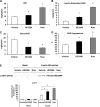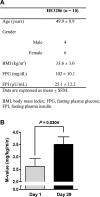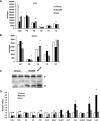A new antidiabetic compound attenuates inflammation and insulin resistance in Zucker diabetic fatty rats
- PMID: 20159859
- PMCID: PMC2867370
- DOI: 10.1152/ajpendo.00668.2009
A new antidiabetic compound attenuates inflammation and insulin resistance in Zucker diabetic fatty rats
Abstract
Tissue macrophage inflammatory pathways contribute to obesity-associated insulin resistance. Here, we have examined the efficacy and mechanisms of action of a novel anti-inflammatory compound (HE3286) in vitro and in vivo. In primary murine macrophages, HE3286 attenuates LPS- and TNFalpha-stimulated inflammation. In Zucker diabetic fatty rats, inflammatory cytokine/chemokine expression was downregulated in liver and adipose tissue by HE3286 treatment, as was macrophage infiltration into adipose tissue. In line with reduced inflammation, HE3286 treatment normalized fasting and fed glucose levels, improved glucose tolerance, and enhanced skeletal muscle and liver insulin sensitivity, as assessed by hyperinsulinemic euglycemic clamp studies. In phase 2 clinical trials, HE3286 treatment led to an enhancement in insulin sensitivity in humans. Gluconeogenic capacity was also reduced by HE3286 treatment, as evidenced by a reduced glycemic response during pyruvate tolerance tests and decreased basal hepatic glucose production (HGP) rates. Since serum levels of gluconeogenic substrates were decreased by HE3286, it indicates that the reduction of both intrinsic gluconeogenic capacity and substrate availability contributes to the decrease in HGP. Lipidomic analysis revealed that HE3286 treatment reduced liver cholesterol and triglyceride content, leading to a feedback elevation of LDL receptor and HMG-CoA reductase expression. Accordingly, HE3286 treatment markedly decreased total serum cholesterol. In conclusion, HE3286 is a novel anti-inflammatory compound, which displays both glucose-lowering and cholesterol-lowering effects.
Figures









References
-
- Abdul-Ghani MA, Matsuda M, Balas B, DeFronzo RA. Muscle and liver insulin resistance indexes derived from the oral glucose tolerance test. Diabetes Care 30: 89–94, 2007 - PubMed
-
- Arkan MC, Hevener AL, Greten FR, Maeda S, Li ZW, Long JM, Wynshaw-Boris A, Poli G, Olefsky J, Karin M. IKK-beta links inflammation to obesity-induced insulin resistance. Nat Med 11: 191–198, 2005 - PubMed
-
- Auci D, Kaler L, Subramanian S, Huang Y, Frincke J, Reading C, Offner H. A new orally bioavailable synthetic androstene inhibits collagen-induced arthritis in the mouse: androstene hormones as regulators of regulatory T cells. Ann NY Acad Sci 1110: 630–640, 2007 - PubMed
-
- Basu R, Dalla Man C, Campioni M, Basu A, Nair KS, Jensen MD, Khosla S, Klee G, Toffolo G, Cobelli C, Rizza RA. Two years of treatment with dehydroepiandrosterone does not improve insulin secretion, insulin action, or postprandial glucose turnover in elderly men or women. Diabetes 56: 753–766, 2007 - PubMed
Publication types
MeSH terms
Substances
Grants and funding
LinkOut - more resources
Full Text Sources
Other Literature Sources
Medical

